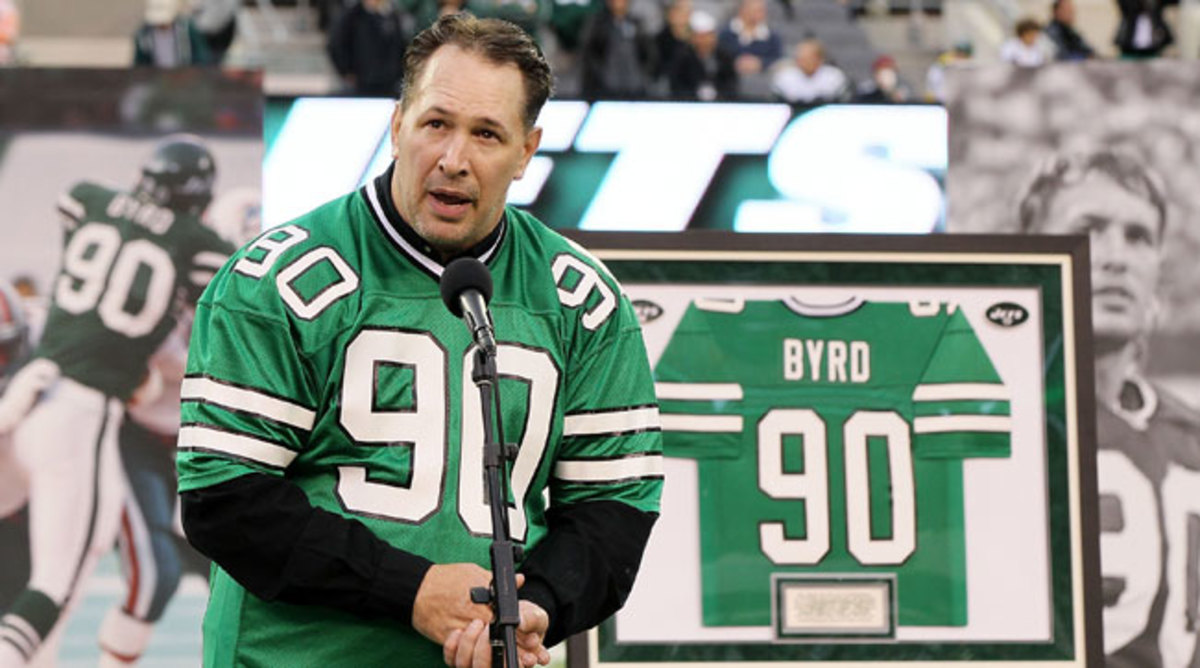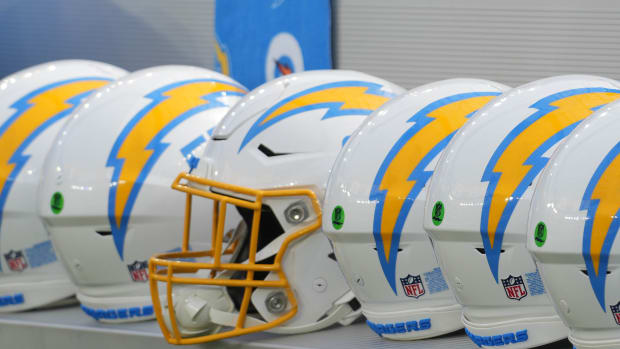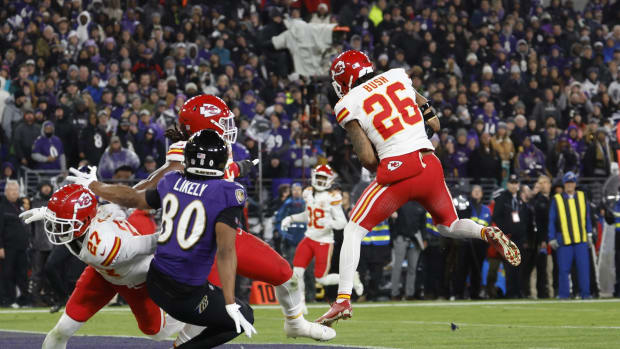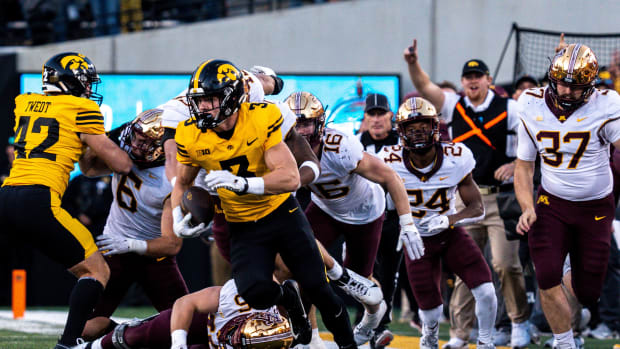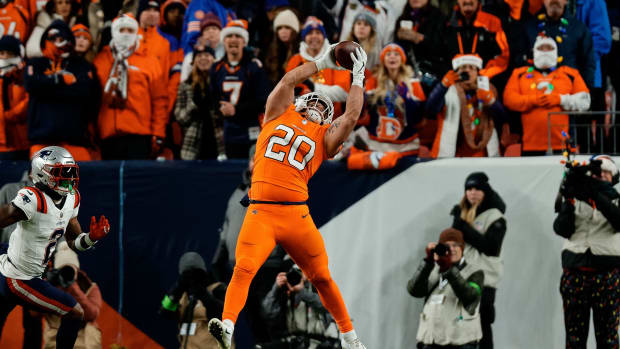The Legend and Life of Dennis Byrd
ROGERS COUNTY, Okla. — On a recent Saturday morning, a father and his 12-year-old son left home to visit a friend. They climbed into an outsized black Hummer H2, buckled their seat belts and drove through the pumpkin-decorated front gate of their family’s 140-acre ranch in the rural plains northeast of Tulsa. Shortly after 11 a.m. they were headed south on State Highway 88, a two-lane road where the speed limit is 65 mph and the broken yellow line allows for passing. In the blink of an eye, nothing would ever be the same again.
Coming toward them in the northbound lane, a 17-year-old was behind the wheel of a white Ford Explorer. For reasons unknown and still being investigated by the Oklahoma Highway Patrol, he crossed into the southbound lane and collided with the Hummer head-on. The H2 splintered into shrapnel and was thrown into an adjacent ditch, where it and the surrounding grass caught fire.
The sky was overcast and the pavement dry on the morning of Oct. 15. According to police, emergency responders found the teen’s cell phone turned off and no signs that he’d been drinking. The road was closed for nearly six hours while investigators tried to make sense of the Ford Explorer’s skid marks, which zigzagged onto the rumble-stripped shoulder and then sharply across the centerline. There was one fatality: The 50-year-old driver of the Hummer, former New York Jet Dennis Byrd, was pronounced dead at the scene from “massive bodily injuries.”
The news was a gut punch to those in the football world near and far, from the University of Tulsa, Byrd’s alma mater; to the Jets’ headquarters in New Jersey; to Pete Carroll in Seattle; to Rex Ryan in Orchard Park, N.Y.; to the CFL, where Brock Sunderland, the son of the scout who convinced the Jets to draft Byrd in 1989, is the assistant general manager of the Ottawa Red Blacks; to dozens of points in between and beyond where Byrd’s teammates were overcome with grief.
“I just dropped on the floor,” says Scott Mersereau, the former Jets defensive end, “and started crying.”
* * *
Nearly 24 years earlier, on Nov. 29, 1992, Mersereau and Byrd, teammates on the Jets’ defensive line, had a fateful collision on the Meadowlands turf. The play call was a stunt, and they were to take looping paths and converge on the quarterback. But the Chiefs’ Dave Krieg stepped up in the pocket and Byrd instead flew headfirst into Mersereau. As he lay on the ground, linebacker Kyle Clifton urged him, “Get up, Dennis.” Replied Byrd, “I don’t think I can, Kyle. I think I’m paralyzed.”
The fifth cervical vertebra in Byrd’s neck had shattered into hundreds of pieces, leaving him unable to move any body part below his neck except his right biceps. Two days later, on the Jets’ off day, many of Byrd’s teammates ringed his bed at Lenox Hill Hospital in New York City. Byrd, flat on his back, had his head immobilized in a halo ring, but a pair of prism glasses allowed him to see their faces. He could tell they didn’t know what to say, so he spoke first.
“I love you guys,” Byrd said. “If it had to happen to one of us, I’m glad it was me.” Later, in a private moment with Mersereau, Byrd told him, “I’ve been worried about you.”
He meant it, too. Byrd was the kind of player who never seemed to be out of position on the field—and he was the same way off it, always putting trust in his religious faith. The Wednesday before his last NFL game, at Bible study with teammates, they read Acts 3, a verse in which Peter heals a lame man. “In the name of Jesus Christ of Nazareth,” the scripture reads, “rise up and walk.” Less than three months after confronting the possibility of being a lifelong quadriplegic, Byrd stood up and put one foot in front of the other. In doing so, the once up-and-coming NFL defender became the most inspirational player to wear a Jets uniform.
His agent, Rick Schaeffer, recalls reporters trying to send tape recorders up to Byrd’s hospital room to snag a quote; Schaeffer was sifting through as many as 100 media requests a day. Byrd was on the nightly news and on the morning shows, and Fleetwood Mac dedicated a Super Bowl XXVII performance of “Say You Love Me” to Byrd and his high school sweetheart, Angela. Dennis authored a book, Rise & Walk, that was made into a movie.
It was a seismic shift for a kid from rural Oklahoma who, in a freshman questionnaire for the Tulsa athletic department, had listed “going to Six Flags” as his most memorable life event to date. He’d become famous for the end of his football career, when all he ever wanted was to play the game, famous or not. When the spotlight faded, he withdrew from the public eye, to the point that teammates grew concerned. He lived with the aftereffects of that 1992 collision every day until his death, dealing with constant pain and a void that could never be filled—a burden he felt obligated to carry only privately.
“If there was a negative in everything we did,” Schaeffer says, “it was that the legend of Dennis Byrd became too big for a human being to live up to.”
* * *
Dennis Byrd’s presence lingers at the University of Tulsa. He still ranks second on the school’s career sacks list, and the current players lift weights in front of a wall adorned with his picture and words: It is a man’s will, a man’s spirit that will tell him you can do it, and it will make the mind and the body follow along.
Defensive coordinator Bill Young, who had recruited Byrd to the university in 1984 and is now in his second stint with the program, had placed a copy of Rise & Walk at the front of his office bookshelf, a reminder to bring his former player in to talk to the team sometime in the coming few weeks.
Visits from Byrd had become rare over the past few years. He preferred to simply show up in the stands for a game like any other fan, wearing a low-slung baseball cap and not wanting to draw attention away from the current team. One of Byrd’s college teammates, Dan Bitson, is now Tulsa’s director of player development. He recalls one head coach inquiring about Byrd’s joining the staff as an assistant, but says, “Dennis wasn’t interested in all that. Football, it takes a piece of you when go through something like he did.”
And Byrd, a defensive player who would spike the ball to celebrate big plays, loved football. Marv Sunderland, a national college scout for the Jets in the 1980s, locked onto Byrd when he put himself back into a blowout loss, with an ankle injury, against coach’s orders, because the opponent was on the goal line and he couldn’t bear for them to score again. “He was the one in every few thousand that loves football to the point of loving training camp,” says Jets teammate Paul Frase.
A second-round pick in 1989, Byrd set a Jets rookie record with seven sacks, but he really started excelling when Pete Carroll was hired as defensive coordinator a year later. Carroll installed a 4-3 scheme and moved Byrd to the 3-technique defensive tackle position, where he was empowered to be more disruptive. He produced 13 sacks that first season under Carroll, an impressive total in any era but especially before the NFL became a passing league.
“I don’t want people to forget,” teammate Marvin Washington says, “that he was an absolute ass-kicker on the field.”

With his wife, Angela, behind him, Byrd walks into his press conference at Mount Sinai on Feb. 11, 1993.
Michael Schwartz/Getty Images
It wasn’t until his teammates had retired after playing careers that lasted 10 or 11 years that they realized what a shock it must have been for Byrd to have his career suddenly cut short at age 26. Looking back, Washington wishes he had called Byrd every Sunday to make him part of the game-day routine, believing that’s what Byrd would have done if the roles had been reversed. “I know he struggled,” Carroll says. “He never got over the fact of what he lost. And even though he came back so far, it wasn’t enough for him. He wanted to get back to playing. He wanted to get back to the game he loved—and the players, and the team and all that he had expected to be part of his life. It was really hard on him. I know he had some really tough, dark times trying to make it through it.”
So much had gone right in the immediate aftermath of the collision, from athletic trainer Pepper Burruss rushing onto the field to immobilize Byrd’s head, to Byrd’s being in the care of Kristjan Ragnarsson, an international expert in rehabilitating patients with spinal cord injuries. And there was such initial triumph when Byrd walked into a press conference at Mount Sinai Hospital, in February 1993, that few understood what would come next.
For the rest of his life, Byrd walked deliberately, having to think about every movement in order to make it happen, an exhausting practice akin to trudging through a snow drift. He suffered from Brown-Séquard syndrome, in which the hemispheres of his body were affected differently by the spinal cord injury, leaving the left side of his body with less sensation and the right side with less motor control. Later in life he used a cane. Large motor functions, such as throwing a football, were no longer possible. Instead he picked up the hobby of clay sculpting, which he mastered using his fine motor skills. (Friends vouch for his creations as Frederic Remington quality.) Ten years after the collision he told the Tulsa World that he’d regained only 20 percent of the strength and muscle capacity that he’d had on his 6'5", 240-pound body. Because of the trauma he suffered, even that strength waned with age. Several years ago Byrd considered having a device surgically implanted to alleviate the pain in his back and neck with electrical impulses, but didn’t go through with it. He rarely talked about his daily pain; when friends would press him, he’d simply say it was “indescribable.”
“What I have come to realize is that there is a huge gap between sympathy and empathy,” Frase says. “We can all sympathize and have a heartfelt connection, but unless we’ve lived in his shoes and gone through it, none of us can really understand what was going on in Dennis’s life and mind. It tortured him that he couldn’t play anymore.”
The winter after his football career ended, Byrd was determined to take one of his beloved hunting trips. He convinced teammate Jeff Lageman, who grew up near Washington, D.C., and wasn’t an avid outdoorsman, to join him. The two had formed a close bond while Byrd was in the hospital. Out of the lineup with a torn ACL, Lageman was the one who snuck Italian food and Dr. Peppers into Byrd’s hospital room against doctors’ orders. When Lageman stood over the bed and began crying, Byrd told him, “Jeff, don’t go soft on me now.” Lageman remembers sitting bedside and watching Byrd stare at his big toe, willing it to move. “Many times, I would stare at that toe with him,” Lageman says.
They drove west of Albuquerque on the hunting trip, to a vast expanse of land near the Four Corners in the Navajo Nation. Byrd used a walking stick as they stalked coyote and mule deer, and since he couldn’t feel the temperature normally, Lageman pleaded with him to put on more layers to stave off hypothermia.
It became an annual tradition for more than a decade. In the early 2000s, the friends hunted deer on a parcel of land that Byrd owned in Oklahoma. “We had a conversation one night when he told me how much he missed the game,” Lageman says. “He always said, if he could do it all over again, he would. The risks, it didn’t matter. It was hard to have it taken away. He could never find anything that filled that void.”
* * *
In January 2011, Dennis Byrd sent a package to Brock Sunderland’s home and followed up with a phone call to give explicit instructions: Please hand-deliver it to Rex Ryan.
Sunderland, who followed in his father’s footsteps and became a scout for the Jets, had first met Byrd when Sunderland was 10 and tagging along with Dad to work. Byrd took the boy out for ice cream the night before a game in San Diego. The next summer Brock was a ball boy at training camp and glued himself to Byrd. He hung out by his locker and watched Byrd end every day by kissing a picture of his wife, Angela, and their first daughter, Ashtin.
Now the Jets were preparing for a divisional round playoff game against the Patriots, six weeks after they’d been embarrassed, 45-3, in a regular-season game at Foxborough. When Sunderland opened the box, he was taken aback. It was the jersey that had been cut off Byrd on the day of his last football game. Enclosed was a note for Ryan and his team: If I could come back from that, you can certainly go to New England and win.
Byrd’s message wasn’t for Ryan to share, the Jets coach decided. That was for Byrd to do himself. Ryan invited him to New England and, the night before one of the biggest games of his coaching career, turned the team meeting over to Byrd.
“You could hear a pin drop,” Ryan says. “This was a guy who was paralyzed on the football field, and to hear him say that he loved the game of football so much that he would give anything to play one more game—you just knew he was telling the truth. And he wanted to play for our team. Not just any team. Our team. We all carried that with us.”
The Jets’ four captains carried Byrd’s jersey out for the coin toss. They upset the Patriots, 28-21 that day to advance to the AFC Championship Game. It was the first Jets game Byrd had attended since the 1993 opener, when, less than a year after his paralyzing collision, he walked to midfield as an honorary captain. After his career ended, he had stayed in the spotlight for a few years, promoting the book and movie; traveling as a motivational speaker; and working briefly as a color commentator for CBS, paired with James Brown.
Byrd soon began to retreat from public view, though he kept under-the-radar connections to football. He put on a football camp, with the help of Lageman and Frase shortly after both retired in 1998, on the Navajo lands where he hunted. None of the kids had played football before. The night before the closing dinner, Byrd stayed up until 2 a.m., not just memorizing a speech, but memorizing it in Navajo. “That’s how driven Dennis was,” Frase says.
Byrd also spent time as a volunteer defensive line coach at Lincoln Christian, a high school near his home in Tulsa. The kids didn’t know much about fundamentals when the program started in 2002, and Byrd got a kick out of teaching them. As a Jets player, he had an unstoppable pass rush move—the chop-swim—that his teammates tried in vain to imitate. Joe Uzzel, a defensive lineman from Lincoln Christian, went on to play at Pittsburg State, in Kansas, where he was part of a national championship team in 2011.
“The coach told me Joe had a move no one could stop,” says Darren Melton, Lincoln Christian’s coach. “When they asked him, Where did you learn that? he said, ‘Coach Byrd taught me.’ ”
* * *
Over the past decade, Dennis Byrd became harder and harder for his teammates to reach. Frase last saw him about eight years ago while traveling to Oklahoma City for business. Unable to get Byrd on the phone, he left a message saying he’d literally be showing up on his doorstep. During the hours they spent together, Byrd showed Frase a room full of his sculptures, which he’d had bronzed. Around the same time, Lageman had been trying to plan another hunting trip, but he and Byrd were having trouble matching their schedules. When Lageman called to catch up a few weeks later, Byrd had changed his number.
“He just kind of detached a little bit,” Lageman says. “And I don’t know what happened. A lot of people wanted to meet him because they gained inspiration from him. I don’t know if he felt pressure from that. Maybe his death would have been easier for me to handle if I had been talking to him for the last couple years. I was never mad at him. I just figured at some point we’d reconnect and pick up right where we left off.”
Not too long ago Washington reached out to Byrd via Facebook because they hadn’t spoken in a while. “Just because we haven’t talked,” Byrd wrote back, “does not change the way I feel about you, Marvin.” As he’d done so many times before, Byrd had been the one to comfort a friend.
Washington, who works as a spokesman for a company that researches therapeutic treatments such as cannabis for the symptoms of CTE, wonders if Byrd’s withdrawal was a sign of mood changes that often come with the degenerative brain disease that has been found in dozens of deceased NFL players. It will be impossible to know, however, and it is probably unfair to guess if Byrd suffered from this disease. CTE can only be diagnosed after death through an analysis of brain tissue. Because of the nature of crash that claimed Byrd’s life, Schaeffer says, his brain was not viable for donation. “He did become reclusive from everyone but his family,” Schaeffer says. “He sort of shut down other parts of life … what triggered that, I can’t say and wouldn’t want to speculate.”
Byrd was last in an NFL stadium in October 2012, when the Jets formally retired his No. 90 jersey, though it had never been worn by another player. Hurricane Sandy struck that weekend, and he and Mersereau ended up being stranded in a New Jersey hotel together not far from the Meadowlands. They found a restaurant in Hackensack adjacent to a fire station that still had power and, for the last time, caught up on old times.
“I can’t stop thinking about him,” Mersereau says. “You drive down the road, and you can’t stop thinking to yourself, all it takes is somebody to—whether it is texting or playing on the radio … you just don’t know how long you are going to be on this earth.”
* * *
The final accident report from the Oklahoma Highway Patrol won’t be completed for a few weeks. Investigators still aren’t sure why the teenager, who was taken to the hospital in stable condition, crossed the centerline, or what caused Byrd’s death, beyond his suffering “massive bodily injuries.”
But this is what they do know: Moments after the collision, another car came upon the scene. Dan Dunkel, a 66-year-old grandfather who had his wife, German shepherd and two grandsons in the car, stopped to help. Dunkel lives in a nearby town and might otherwise have been home if his grandson hadn’t been playing quarterback in a football game that morning. He instructed his wife to call 911 while he ran toward the Hummer, smoke billowing out of its engine like a dust storm. Instinctively, he went to the passenger side. He opened the door and fumbled around the shards of metal, feeling for the seatbelt button. Though he’s only 5'3", Dunkel yanked Byrd’s 12-year-old son, Zach, from the wreckage.
Dunkel then ran to the other side, but driver’s side door was jammed shut. Reaching through the broken window, Dunkel couldn’t feel a pulse. Soon, the car was engulfed in flames.
“Goodbye, Dad,” he heard the boy whisper. “I’ll see you later.”
Eight days later, Zach sat in the back seat of a golf cart at MetLife Stadium wearing a No. 90 jersey. His left ankle was in a blue cast, and he’d had surgery to insert a titanium rod into his broken femur following the accident. With his leg outstretched on the back of the cart, he rode to midfield before kickoff of the Jets-Ravens game. His mom sat in the front, while his three sisters walked alongside. Angela Byrd, as strong and pretty as she was that day in 1993 when her husband walked out of the hospital, would later apologize for not being ready to talk publicly yet. Her only comments have come via her Facebook page, which she updated in her son’s hospital room: “Zach’s dad will also become his inspiration to RISE AND WALK!!”
Before a crowd of 78,160, the Jets held a moment of silence. Byrd’s former teammates Marvin Washington, Bill Pickel, Paul Frase and Scott Mersereau joined the family at midfield. And in that moment they had an understanding of what it was like to be in Dennis Byrd’s shoes, quietly enduring indescribable pain.
Question? Comment? Let us know at talkback@themmqb.com
































